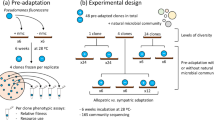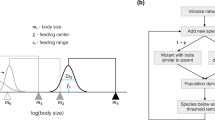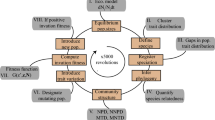Abstract
Positive relationships between species diversity and productivity have been reported for a number of ecosystems1,2. Theoretical and experimental studies have attempted to determine the mechanisms that generate this pattern over short timescales1,2, but little attention has been given to the problem of understanding how diversity and productivity are linked over evolutionary timescales. Here, we investigate the role of dispersal in determining both diversity and productivity over evolutionary timescales, using experimental metacommunities of the bacterium Pseudomonas fluorescens assembled by divergent natural selection. We show that both regional diversity and productivity peak at an intermediate dispersal rate. Moreover, we demonstrate that these two patterns are linked: selection at intermediate rates of dispersal leads to high niche differentiation between genotypes, allowing greater coverage of the heterogeneous environment and a higher regional productivity. We argue that processes that operate over both ecological and evolutionary timescales should be jointly considered when attempting to understand the emergence of ecosystem-level properties such as diversity–function relationships.
This is a preview of subscription content, access via your institution
Access options
Subscribe to this journal
Receive 51 print issues and online access
$199.00 per year
only $3.90 per issue
Buy this article
- Purchase on Springer Link
- Instant access to full article PDF
Prices may be subject to local taxes which are calculated during checkout




Similar content being viewed by others
References
Loreau, M. et al. Biodiversity and ecosystem functioning: current knowledge and future challenges. Science 294, 804–808 (2001)
Hooper, D. U. et al. Effects of biodiversity on ecosystem functioning: a consensus of current knowledge. Ecol. Monogr. 75, 3–35 (2005)
Cardinale, B. J., Nelson, K. & Palmer, M. A. Linking species diversity to the functioning of ecosystems: on the importance of environmental context. Oikos 91, 175–183 (2000)
Mouquet, N., Moore, J. L. & Loreau, M. Plant species richness and community productivity: why the mechanism that promotes coexistence matters. Ecol. Lett. 5, 56–65 (2002)
Hanski, I. A. & Gaggiotti, O. E. Ecology, Genetics and Evolution of Metapopulations (Elsevier Academic, Burlington, 2004)
Holyoak, M., Leibold, M. A. & Holt, R. D. Metacommunities: Spatial Dynamics and Ecological Communities (Chicago Univ. Press, Chicago, 2005)
Levene, H. Genetic equilibrium when more than one ecological niche is available. Am. Nat. 87, 331–333 (1953)
Day, T. Competition and the effect of spatial resource heterogeneity on evolutionary diversification. Am. Nat. 155, 790–803 (2000)
Amarasekare, P. & Nisbet, R. Spatial heterogeneity, source-sink dynamics, and the local coexistence of competing species. Am. Nat. 158, 572–584 (2001)
Mouquet, N. & Loreau, M. Coexistence in metacommunities: the regional similarity hypothesis. Am. Nat. 159, 420–426 (2002)
Cadotte, M. W. & Fukami, T. Dispersal, spatial scale, and species diversity in a hierarchically structured experimental landscape. Ecol. Lett. 8, 548–557 (2005)
Habets, M., Rozen, D. E., Hoekstra, R. F. & de Visser, J. The effect of population structure on the adaptive radiation of microbial populations evolving in spatially structured environments. Ecol. Lett. 9, 1041–1048 (2006)
Prosser, J. I. et al. The role of ecological theory in microbial ecology. Nature Rev. Microbiol. 5, 384–392 (2007)
Cohan, F. M. What are bacterial species? Annu. Rev. Microbiol. 56, 457–487 (2002)
Kassen, R. The experimental evolution of specialists, generalists, and the maintenance of diversity. J. Evol. Biol. 15, 173–190 (2002)
Barrett, R. D. H., MacLean, R. C. & Bell, G. Experimental evolution of Pseudomonas fluorescens in simple and complex environments. Am. Nat. 166, 470–480 (2005)
Hall, A. R. & Colegrave, N. How does resource supply affect evolutionary diversification? Proc. R. Soc. Lond. B 274, 73–78 (2007)
Lenormand, T. Gene flow and the limits to natural selection. Trends Ecol. Evol. 17, 183–189 (2002)
Bruno, J. F., Stachowicz, J. J. & Bertness, M. D. Inclusion of facilitation into ecological theory. Trends Ecol. Evol. 18, 119–125 (2003)
Cardinale, B. J., Palmer, M. A. & Collins, S. L. Species diversity enhances ecosytem functioning through interspecific facilitation. Nature 415, 426–429 (2002)
Loreau, M. & Hector, A. Partitioning selection and complementarity in biodiversity experiments. Nature 412, 72–76 (2001)
Treves, D. S., Manning, S. & Adams, J. Repeated evolution of an acetate-crossfeeding polymorphism in long-term populations of Escherichia coli. Mol. Biol. Evol. 15, 789–797 (1998)
Loreau, M. Biodiversity and ecosystem functioning: A mechanistic model. Proc. Natl Acad. Sci. USA 95, 5632–5636 (1998)
Tilman, D., Lehman, C. L. & Thomson, K. T. Plant diversity and ecosystem productivity: Theoretical considerations. Proc. Natl Acad. Sci. USA 94, 1857–1861 (1997)
Hector, A. et al. Plant diversity and productivity experiments in European grasslands. Science 286, 1123–1127 (1999)
Fussmann, G. F., Loreau, M. & Abrams, P. A. Eco-evolutionary dynamics of communities and ecosystems. Function. Ecol. 21, 465–477 (2007)
Bell, G. The ecology and genetics of fitness in Chlamydomonas. 1. Genotype-by-environment interaction among pure strains. Proc. R. Soc. Lond. B 240, 295–321 (1990)
McGill, B. J., Enquist, B. J., Weiher, E. & Westoby, M. Rebuilding community ecology from functional traits. Trends Ecol. Evol. 21, 178–185 (2006)
Cooper, V. S. & Lenski, R. E. The population genetics of ecological specialization in evolving Escherichia coli populations. Nature 407, 736–739 (2000)
Acknowledgements
This work was supported by research grant ‘Programme National EC2CO’ (to N.M. and P.A.V.), by ‘Le Fond National de la Science’ and ‘Programme Microbiologique’ (to M.E.H.) and grants from NERC UK to the Centre for Population Biology (to R.C.M.). We thank B. Bochner for advice on the Biolog microplates, C. Bouvier for methodological advices and help with the spectrophotometer, and C. de Mazancourt and I. Olivieri for discussions. R. Barrett provided the ancestral bacterial strain. T. Bell, B. Facon and V. Ravigné provided comments on an earlier version of our manuscript.
Author information
Authors and Affiliations
Corresponding authors
Supplementary information
Supplementary Information
This file contains Supplementary Figure 1 and Legend, Supplementary Discussion and Supplementary Note with additional references. The Supplementary Figure 1 shows the proportion of total phenotypic variance explained by responsiveness for each dispersal treatment. The liner test shows a decrease in responsiveness with dispersal. The Supplementary Discussion treats non substrate-specific mutations that may generate an increase in fitness simultaneously in more than one substrate. In our treatments with dispersal, beneficial mutations generated ex situ (even those not substrate-specific) are constantly introduced by migration, allowing adaptation to ‘poor’ quality habitats. The Supplementary Note includes the references cited in Supplementary Discussion. (PDF 82 kb)
Rights and permissions
About this article
Cite this article
Venail, P., MacLean, R., Bouvier, T. et al. Diversity and productivity peak at intermediate dispersal rate in evolving metacommunities. Nature 452, 210–214 (2008). https://doi.org/10.1038/nature06554
Received:
Accepted:
Issue Date:
DOI: https://doi.org/10.1038/nature06554
This article is cited by
-
Consequences of mutation accumulation for growth performance are more likely to be resource-dependent at higher temperatures
BMC Ecology and Evolution (2021)
-
Coexistence, dispersal and spatial structure in metacommunities: a stochastic model approach
Theoretical Ecology (2021)
-
Ecological drivers of global gradients in avian dispersal inferred from wing morphology
Nature Communications (2020)
-
Evolution of diversity explains the impact of pre-adaptation of a focal species on the structure of a natural microbial community
The ISME Journal (2020)
-
Coexistence of Competing Species for Intermediate Dispersal Rates in a Reaction–Diffusion Chemostat Model
Journal of Dynamics and Differential Equations (2020)
Comments
By submitting a comment you agree to abide by our Terms and Community Guidelines. If you find something abusive or that does not comply with our terms or guidelines please flag it as inappropriate.



